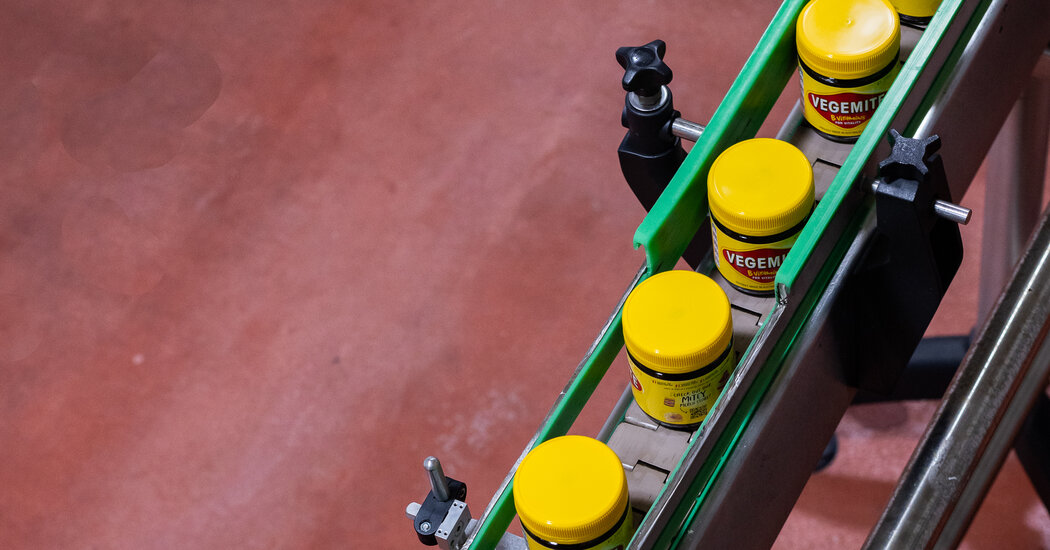[ad_1]
Just off Australia’s largest container port lies a sickle-shaped neighborhood with a scent so distinctive that passing taxi drivers will sometimes roll down their windows for a whiff of the rich and unmistakably beery aroma.
That smell, officially recognized by the City of Melbourne last year for its “intangible cultural heritage,” emanates from a nondescript, brick factory on a corner lot in this industrial district, known as Port Melbourne. Every vessel of Vegemite, the spread beloved in Australia and not so much outside it, has for the past 80 years begun its journey here.
Glinting glass jars, each filled with a swirl of semi-molten Vegemite, quiver as they clink along metal rollers on the assembly line before being bunched into squadrons of 12 and sent out into the world.
Australians hanker for Vegemite. It is in over 90 percent of the country’s homes, according to Bega Group, the company that makes it. Many, if not most, cafes have a vat in their kitchens, and dinky jars of less than one ounce dot airport lounges across the country.
The brand celebrated its 100th birthday this year, prompting ridiculous merchandise (fine silver replicas of Vegemite jars that sold out in four hours) and an abundance of questionable collaborations (Vegemite oats, Vegemite roast chicken, Vegemite Taco Bell). But it is far from clear what Vegemite, in all its tarry glory, actually is.
What does the “concentrated yeast extract” on the label mean?
“I’m not sure that that necessarily matters,” Matt Gray, the marketing manager at Bega, said a bit guardedly. “I don’t think that anyone thinks that deeply about it.”
When pushed, Vegemite officials offer few clues. It is made of leftover yeast from local breweries and bakeries; requires a multiweek fermentation process; involves salt, and maybe onions and celery; and is an excellent source of vitamins. (Most people eat it on toast in quantities far less than the typical slather of peanut butter on bread.) The process almost certainly cannot be replicated in a home kitchen.
“It’s top secret,” Robert Carman, the factory manager, who has worked at the plant for 51 years, said of the recipe.
Five days a week, in a room decorated with photographs of toast, Mr. Carman and a rotating crew of tasters sample each batch. They look for firmness, “squeezability” and a flavor that hits precisely the right notes of saltiness and bitterness.
The rest of the world looks on with something approaching wry bemusement. In a journal article in 2003, the psychologists Paul Rozin and Michael Siegal found that Vegemite was “a candidate for the most culturally specific food.” Ben Shewry, the celebrated chef behind the Melbourne restaurant Attica, compares enjoying Vegemite to skateboarding.
“You have to have done it as a child,” said Mr. Shewry, who is originally from New Zealand. “It’s too painful to learn it as an adult.”
Vegemite evokes visceral reactions. More than a decade ago, President Barack Obama threw diplomatic norms aside, cutting off Julia Gillard, then the Australian prime minister, to proclaim: “It’s horrible.”
Yet for many immigrants — whether from Colombia, Nepal or Samoa — you cannot become Australian without falling for the national spread.
In 2003, Guido Melo, 47, moved to Melbourne from Brazil with his former partner. He quickly set to assimilating, immersing himself in Australian sports and developing a taste for Vegemite, cheese and prosciutto sandwiches. “I wanted to be part of it so badly,” he said of Australian life.
As a child in suburban Sydney, Hetty Lui McKinnon, a Chinese Australian chef, ate very few Western meals. The one exception, she said, was “very strong” Vegemite sandwiches.
“It definitely made me feel more Australian because I was eating what everybody else was eating,” she said. “My mum didn’t really know how to make a proper Vegemite sandwich, so the ratio of Vegemite to butter was always a little off.”
Ms. McKinnon, now based in Brooklyn, keeps only two Australian foods in her pantry: tinned passion fruit pulp — and a jar of Vegemite. Her book “To Asia With Love” suggests coating egg noodles with a luxurious and soporific emulsion of melted butter, miso paste and Vegemite. (Ms. McKinnon contributes recipes to The New York Times.)
Australians did not always have a taste for Vegemite. Introduced in 1923 as a competitor to Marmite, a British yeast spread, it was not until 1937 that sales began to pick up. Part of the appeal was advertisements promoting the spread as a health food for babies. By World War II, it had become so popular that it accompanied Australian troops overseas, and there were shortages at home.
“Sending it to war really solidified its place in the national diet,” said Jamie Callister, the author of a book about Vegemite’s history and the grandson of Cyril Callister, the food chemist who invented it.
But for most of its history, despite being made and mostly sold in Australia, Vegemite belonged to Kraft, the American food company. It returned to Australian hands when Bega, a dairy company, bought it in 2017.
Kraft made one attempt to sell it to American consumers, in the late 1960s. A campaign by the ad agency J. Walter Thompson eschewed the focus on vitality that had worked at home in favor of one featuring Australian sports stars.
“None of these celebrities would have been known or have had any resonance in the States,” said Emily Contois, a media studies professor at the University of Tulsa.
Interest in Vegemite in the United States did rise organically in the early 1980s, with the popularity of the Men At Work song “Down Under” (lyric: “He just smiled and gave me a Vegemite sandwich”). For the first time, Americans rushed to try it, with Vegemite-eating contests and parties. They mostly did not like what they found.
“They really don’t get it,” said Stephanie Alexander, a doyenne of Australian food writing.
Though usually served on toast, Vegemite comes in many forms in restaurants and cafes across Melbourne. It is baked into cheesy, savory “scrolls” or, at one eatery, added to white chocolate ice cream, where its slight chemical tang lingers on taste buds seemingly for hours.
It even finds its way into fine dining. Mr. Shewry, the chef, makes his own trademark-protected dupe, “Benmite”: a fresh, slightly powdery product of unspecified vegetal origin that has been smeared onto steamed rolls, mixed with butter and squeezed into “cheesy puffs,” or served in a riff on avocado on toast.
For Mr. Shewry, Vegemite is as important a feature of Australian culinary heritage as many Indigenous ingredients.
“We have this tendency to feel ‘cultural cringe’ from really successful things, whether that be Vegemite or a Driza-Bone jacket,” he said, referring to the waterproof overcoats made in Australia for almost a century. “But that thing right there — that’s cool. That’s actually a real part of our culture, and it’s important and valuable.”
More than 90 percent of the roughly 7,500 tons (20 million or so tubs, tubes and jars) of Vegemite made each year is bought in Australia, according to Bega. But the product’s global profile far outstrips its international sales, thanks in part to regular celebrity endorsements (or sometimes censures).
Hugh Jackman brought it onto late-night television; Margot Robbie described the scrape of Vegemite on toast as the sound of her childhood; Tom Hanks revolted a nation (and inadvertently raised awareness about coronavirus-induced anosmia, an abrupt loss of smell) by lathering it on with abandon. Vegemite’s high-profile detractors include the singers Jason Derulo, an American, and Niall Horan, an Irishman who was once part of the boy band One Direction, who both made sour faces after being fed it on live television.
All this attention makes Mr. Callister, the Vegemite scion and historian, optimistic.
“Looking to the next 100 years,” he said, “I still think Vegemite could go global.”
[ad_2]
Source link




